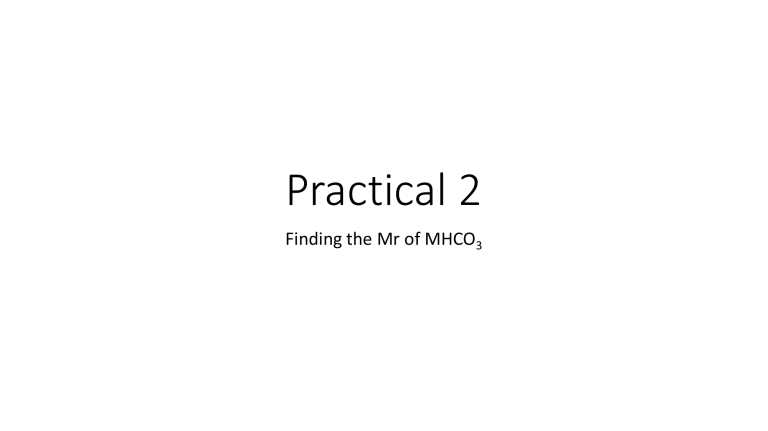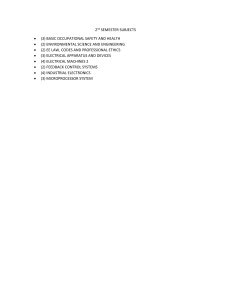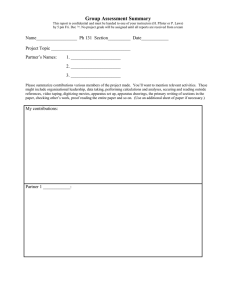
Practical 2 Finding the Mr of MHCO3 burette flask A standard solution is a solution whose concentration is accurately known. This done by weighing out a sample of solute, transferring it completely to a volumetric flask, and adding enough solvent to bring the volume up to the mark on the neck of the flask. METHYL ORANGE acid end-point alkali Titrations • Record your results to the nearest 0.05 cm3 • Calculate your mean titre to two decimal place (does not have to end in 0 or 5) • Concordant results to 0.1cm3 Table Mass /g Weight of MHCO3 / g (before adding to beaker) (boat + solid) 22.78 Weight of MHCO3 / g (after adding to beaker) (boat + residue) 20.24 Final weight of MHCO3 added to beaker (g) 2.54 Analysis • Find the Mr of MHCO3 • • • • • • • • • Mol HCl = c x v = 0.1 x 0.02715 (titre dm3) = 0.002715 (1:1 ratio) Mol MHCO3 in 25cm3 = 0.002715 Mol MHCO3 in 250cm3 = 0.02715 Mr =mass / mol Mr of MHCO3 = 2.54/0.02715 = 93.63 Mr of M = MHCO3 – HCO3 = 93.63 – 61 = 32.6 (potassium Ar = 39.1) M = potassium (closest Ar) K ERRORS - uncertainties The margin of error is the smallest unit the equipment can measure by and then divide by two. As this can go either way we put +/before the value Balance Volumetric flask Pipette Burette Remember to combine the uncertainties: for a burette its 3 x 0.05 (two readings to determine the volume and judging end point to one drop) The balance was used twice as the weighing bottle was reweighed to test for any residue so multiply the uncertainty by x2 Evaluation • Titration is reliable if you achieved concordant results • Mr of KHCO3 = 100.1 (true value for exp error) The real value will be the Mr of KHCO3 you have just calculated from the periodic table 100.1 Comment: If the exp error is greater than the apparatus error then your results are in accurate due to human error Question 5 • Using a balance with such a low accuracy would have a significant impact on the apparatus error and therefore have a higher likeliness of inaccurate results Apparatus error balance(+/- 0.5) : 0.5 x 2/2.54 x 100 = 39.37% Apparatus error balance(+/- 0.01) : 0.01 x 2/2.54 x 100 = 0.78% +/- 0.5 is a bigger margin of error than +/- 0.01, so the apparatus error will be greater Question 6 • Using a measuring cylinder will have a low accuracy and will therefore significantly increase the apparatus error. The results are more likely to be inaccurate due to the larger apparatus error. • Apparatus error (measuring cylinder): 0.5/25 x 100 = 2.00% • Apparatus error (pipette): 0.06/25 x 100 = 0.24% • +/- 0.5 is a bigger margin of error than +/- 0.06 for the pipette, so the apparatus error for the measuring cylinder will be greater than the pipette



